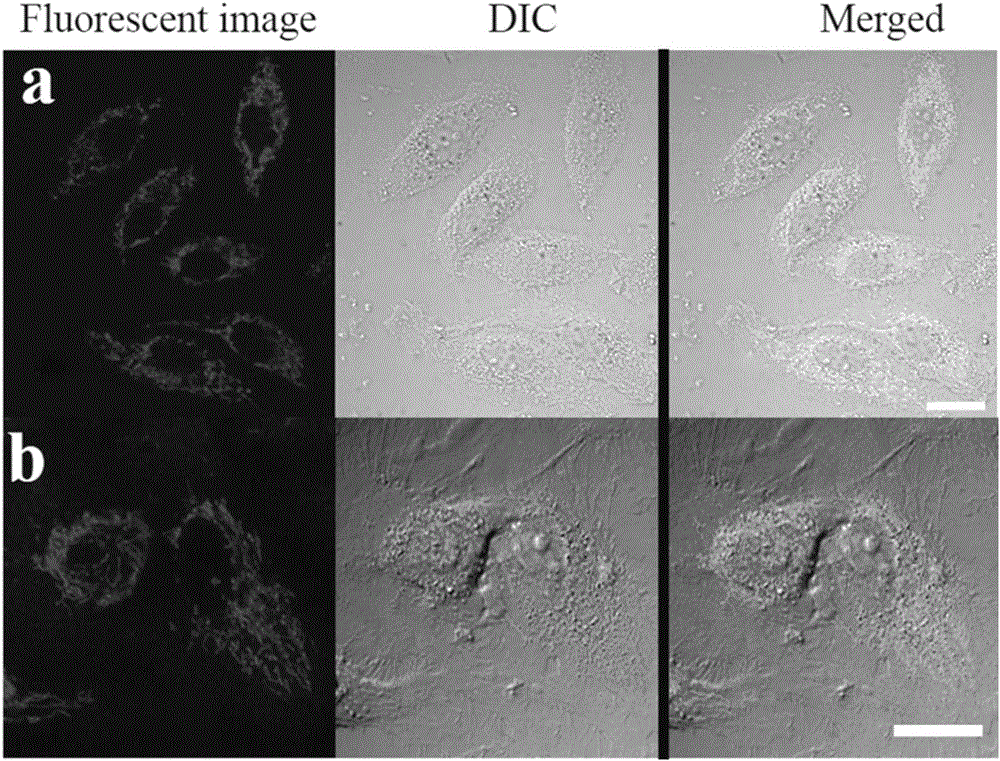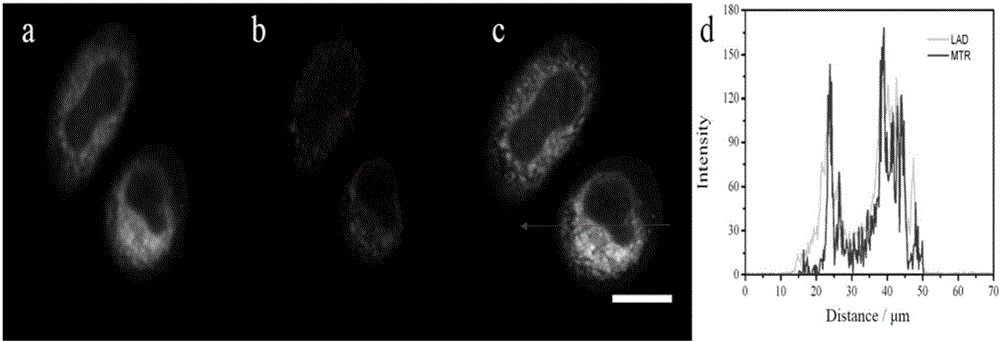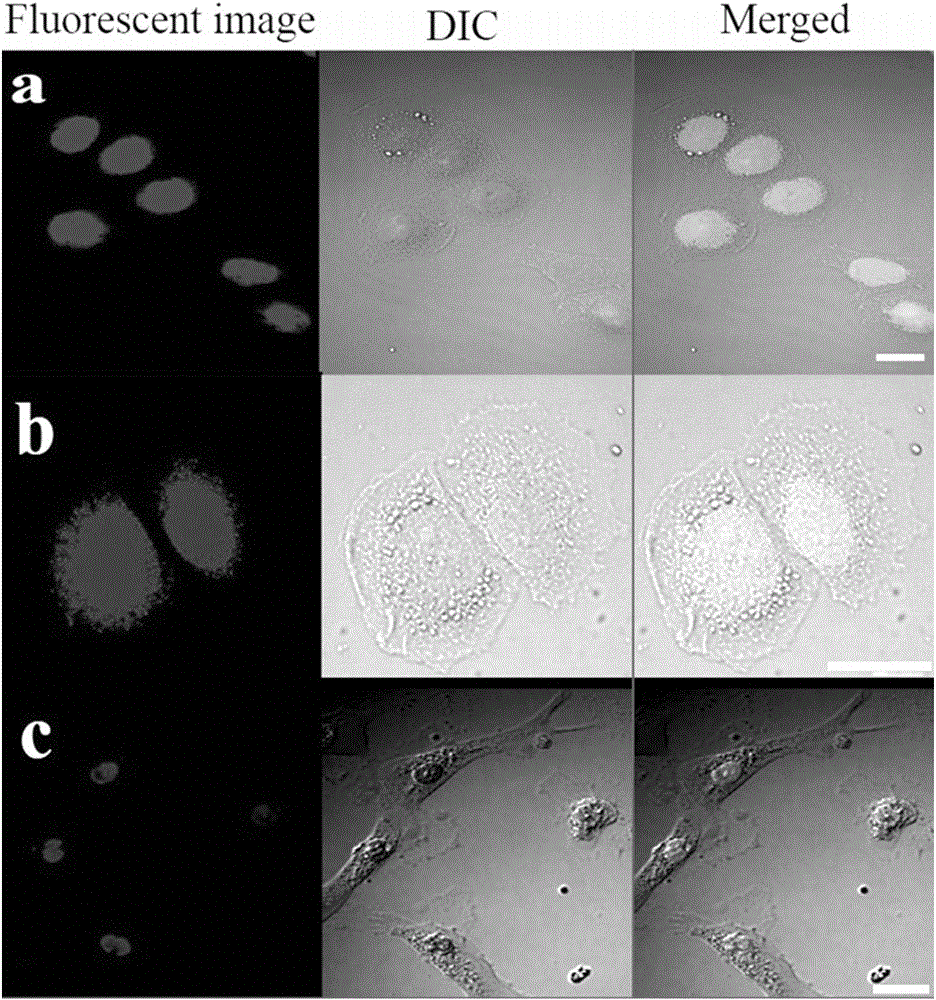Space-dependent type mitochondrial membrane potential fluorescent probe and application thereof
A technology of mitochondrial membrane potential and fluorescent probes, which is applied in the fields of fluorescence/phosphorescence, luminescent materials, and material analysis through optical means. Water solubility and other issues, to achieve good application prospects
- Summary
- Abstract
- Description
- Claims
- Application Information
AI Technical Summary
Problems solved by technology
Method used
Image
Examples
Embodiment 1
[0028] Synthesis and characterization of LAD
[0029] Add 0.185g of compound 9-(2-ethoxyethyl)-3-formyl-6-(4-vinylpyridyl)-carbazole to a 100mL dry three-necked flask, 25mL of dehydrated methanol, and nitrogen Protect, heat up to 55°C, dissolve after heating for 30min, add 0.168g of compound 6 (N-butyl-4-picoline iodide salt), add 6 drops of piperidine, heat up to reflux, overnight, stop heating, After cooling, the solvent was evaporated to dryness, recrystallized with methanol, and dried to obtain 0.06 g of dark red powder with a yield of about 20%.
[0030] 1H NMR (DMSO-d6, 300MHz): δ (ppm): 8.92 (d, J = 6.6Hz, 2H), 8.55 (m, 4H), 8.24 (t, J = 7.8Hz, 3H), 7.88 (m, 2H), 7.77(dd, J=8.3Hz, 2H), 7.72(s, 1H), 7.58(m, 3H), 7.31(m, 1H), 4.63(t, J=4.8Hz, 2H), 4.49( t,J=7.2Hz,2H).3.78(t,J=6.6Hz,2H),3.38(q,J=7.0Hz,2H),0.91(m,2H),0.32(m,2H),0.95( m,6H).13C NMR(DMSO-d6,75MHz):δ(ppm):153.85,150.49,145.20,144.46,142.90,142.75,141.69,134.30,128.71,127.18,126.88,126.88,126.19,123.01, 12...
Embodiment 2
[0032] Immortalized cell (SiHa and HeLa) and normal cell (HUVEC) culture
[0033] All cell lines were stored at 37°C, 5% CO 2 cultured in a saturated humidity incubator. SiHa and HeLa cell lines were cultured adherently in H-DMEM medium containing 10% fetal bovine serum (containing 1% double antibody). HUVEC cell lines were cultured adherently in M199 medium containing 10% fetal bovine serum (containing 2 ng / mL FGF-2). After the cells grow to the logarithmic phase, culture the slices: ① Soak the coverslips in absolute ethanol for 30 minutes, dry them with an alcohol lamp, and place them in a disposable 35mm culture dish; ② Wash the cells in the 100mL cell bottle with PBS. Three times, digest with 1mL 0.25% trypsin for 3-5 minutes, pour out the medium carefully, add a small amount of fresh medium and pipette evenly, after counting the cells, leave cells with a suitable density, add the medium to the required volume ( The final concentration of control cells was 1×10 5 ), in...
Embodiment 3
[0035] LAD staining of SiHa and HUVEC cells with normal MMP and counterstaining with MTR
[0036] Wash the inoculated cell slide three times with PBS, stain the cells with 2 μM LAD, and store in CO 2 After incubating in the incubator for 15 minutes, suck out the culture solution and wash it three times with PBS to wash away the unbound excess dye solution. Place the cell growth side down on the glass slide, and observe the stained part of the cell under a laser scanning confocal fluorescence microscope. Fluorescence distribution and brightness changes, etc. It was found that the distribution area of LAD in the cell was filamentous and similar to mitochondria. Therefore, the counterstaining experiment with the commercial mitochondrial probe MTR was used to prove that LAD was in SiHa with normal MMP and SiHa with normal MMP. Whether the staining location in HUVEC cells is mitochondria.
[0037] Wash the inoculated cell slide three times with PBS, stain the cells with 2 μM LAD...
PUM
 Login to View More
Login to View More Abstract
Description
Claims
Application Information
 Login to View More
Login to View More - Generate Ideas
- Intellectual Property
- Life Sciences
- Materials
- Tech Scout
- Unparalleled Data Quality
- Higher Quality Content
- 60% Fewer Hallucinations
Browse by: Latest US Patents, China's latest patents, Technical Efficacy Thesaurus, Application Domain, Technology Topic, Popular Technical Reports.
© 2025 PatSnap. All rights reserved.Legal|Privacy policy|Modern Slavery Act Transparency Statement|Sitemap|About US| Contact US: help@patsnap.com



